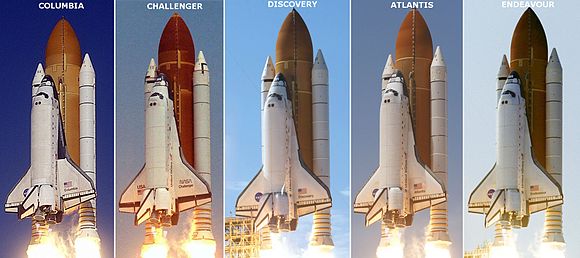Space Shuttle
 Space shuttle program insignia | |||
| Manufacturer | United Space Alliance Thiokol/Alliant Techsystems (SRBs) Lockheed Martin/Martin Marietta (ET) Boeing/Rockwell (orbiter) | ||
|---|---|---|---|
| Country of origin | United States | ||
| Specifications | |||
| Spacecraft type | Crewed orbital launch and reentry | ||
| Payload capacity | 27,500 kilograms (60,600 pounds) | ||
| Crew capacity | 8 | ||
| Production | |||
| Status | Retired | ||
| Built | 5 | ||
| Retired | 3 | ||
| Lost | 2 | ||
| First launch | 12 April 1981, 12:00:03 UTC | ||
| Last launch | 8 July 2011 15:29:00 UTC | ||
| |||
The Space Shuttle was a spacecraft which was used by the American National Aeronautics and Space Administration, or NASA. Space Shuttles were used to carry astronauts and cargo into space. Cargo such as satellites, parts of a space station or scientific instruments were taken up into space by the space shuttle. It was a new kind of spacecraft because it could be used many times.
Parts of the Space Shuttle
[change | change source]
The Space Shuttle was made up of 3 parts. These were the orbiter, the external fuel tank and solid rocket boosters.
The orbiter was shaped like a large airplane with wings and a tail. This allowed the Space Shuttle to glide and land on a runway, letting the reusable part of the Shuttle be very large. Many spacecraft which came before the Space Shuttle, like the Mercury, Gemini and Apollo used parachutes when landing, and landed on the ocean. People have said that the Shuttle was very much like a pickup truck because of its usefulness.
The shuttle was launched out of Earth's gravity and into space by 3 rocket engines on the back of the orbiter along with help from 2 long white Solid Rocket Boosters (also called SRBs)[1] Fuel for the shuttle was stored in the large, usually orange, External Fuel Tank (also called ET). Before the shuttle reached orbit, the SRBs were released and fell into the Atlantic Ocean where they were towed back to shore for reuse. The ET was also released but broke up and fell into the Indian Ocean and was not reused.[2]
Cargo Bay add-ons
[change | change source]Orbiter had a payload bay for various missions rather than deploying satellites. They were the following:
- Spacelab: A laboratory used for experiments in space.
- Spacehab: Similar to Spacelab, but it has multiple kinds.
- Inertial Upper Stage: Upper stage used for sending payloads into higher orbits.
- Payload Assist Module: Similar to IUS, but used solid propellants.
- Extended Duration Orbiter: Cryogenic kit used for extending the duration of the missions.
- Multi-Purpose Logistics Module: Cargo container used for supplying the cargos to International Space Station.
- Canadarm: Robotic arm used for any missions.
The space shuttles
[change | change source]The US space shuttles were:
A '†' next to a name means that the Shuttle was destroyed.
There was a Russian Shuttle called Buran. It flew one unmanned flight before being retired. The Buran was destroyed in a hangar collapse in 2002.

History
[change | change source]The shuttle was created in 1973. It replaced the Apollo capsules. The first flight was a test of the landing and maneuvering abilities of the shuttle. This flight used Space Shuttle Enterprise. The first shuttle flight in space was on April 12, 1981. It used Space Shuttle Columbia.[3]
On January 28, 1986 the Space Shuttle Challenger destroyed 73 seconds into the flight of STS-51-L. It caused a year long stall in space flight.[4]
In the 1990s the Shuttle began working on the International Space Station (ISS). This was its main job of the shuttle since then.
Also in the 1990s, the Space Shuttle launched the Hubble telescope into space. Shuttle missions returned 5 times to repair and improve cameras and scientific instruments on the telescope.
On February 1, 2003, the Space Shuttle Columbia broke up while returning STS-107 to Earth over Texas. The accident was caused by damage to the heat-shield which protects it from the heat of reentry into the Earth's atmosphere. It again caused a long delay until the next shuttle flight.
In 2010, NASA shut down the Space Shuttle program. They were more expensive to use than other launch vehicles.
Currently, the United States has manned spacecraft capabilities, such SpaceX with the Crew Dragon[permanent dead link], to provide crewed missions to the ISS. Boeing with their Starliner capsule is planning, in providing crewed missions to the ISS. NASA is developing the Orion capsule for beyond Earth orbit missions.
The remaining shuttles are now on display at the following museums:
- Enterprise is now at the Intrepid Sea-Air-Space Museum, in New York City. It was formerly at the Steven F. Udvar-Hazy Center.
- Discovery is at the Steven F. Udvar-Hazy Center, Virginia.
- Endeavour is at the California Science Center in Los Angeles, California.
- Atlantis is on display at the Kennedy Space Center Visitor Complex, in Florida.
- Pathfinder Archived 2019-05-04 at the Wayback Machine (test model) is on display at the U.S. Rocket Center in Huntsville, Alabama.
References
[change | change source]- ↑ "SOLID ROCKET BOOSTERS". science.ksc.nasa.gov. Archived from the original on 2019-04-30. Retrieved 2007-05-21.
- ↑ "EXTERNAL TANK". science.ksc.nasa.gov. Archived from the original on 2019-08-19. Retrieved 2007-05-21.
- ↑ "NASA - 1981-1986 Space Shuttle Launches". www.nasa.gov. Archived from the original on 2020-09-29. Retrieved 2019-02-11.
- ↑ KSC, Lynda Warnock (19 January 2016). "STS-51L". NASA.



